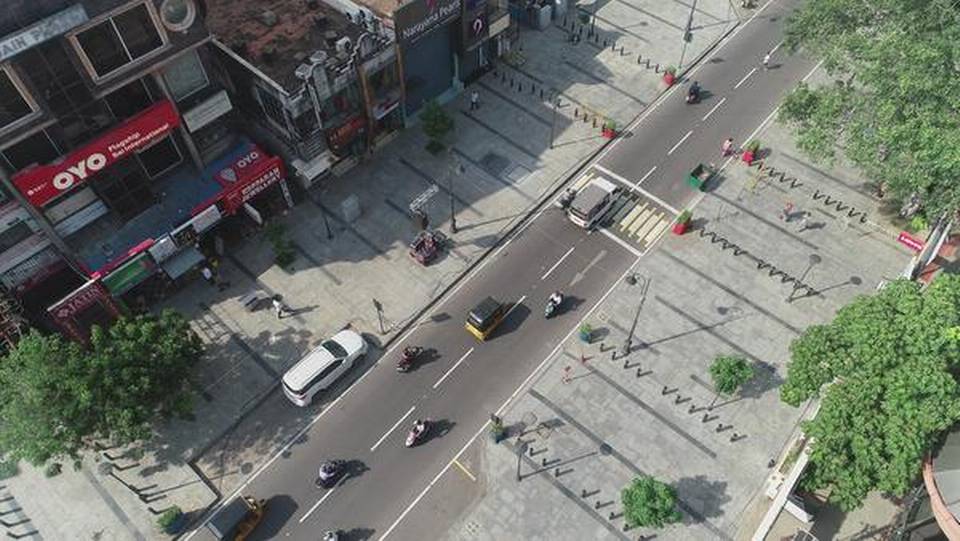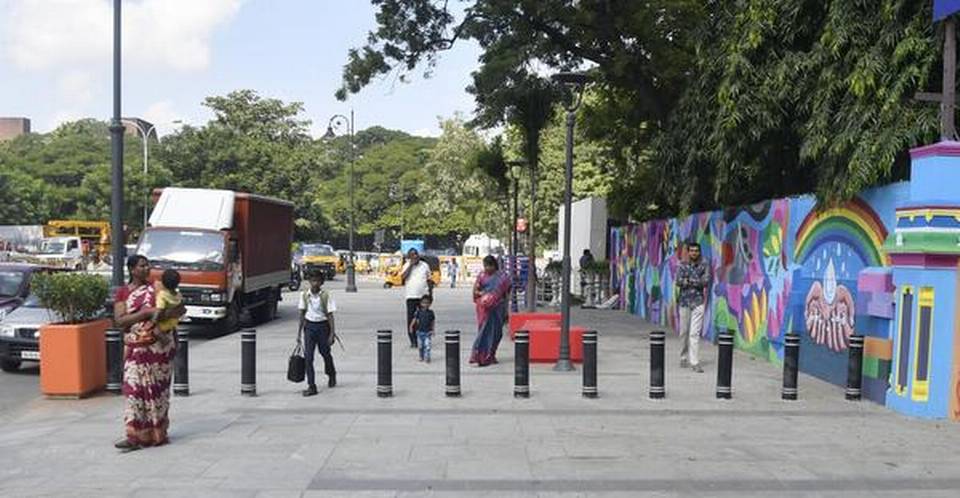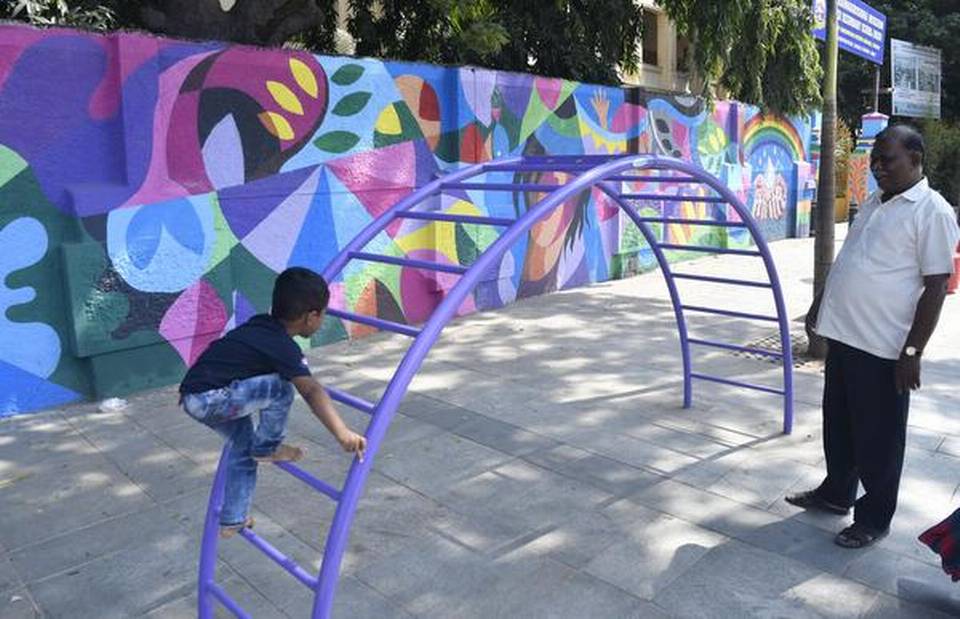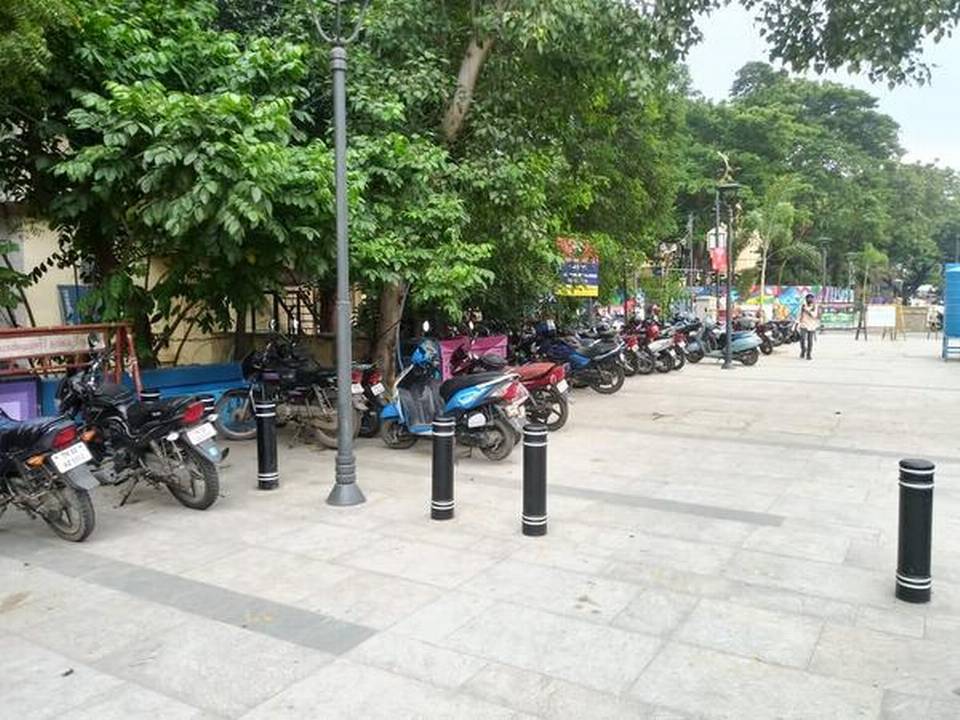
For most Chennaiites, Pondy Bazaar brings back fond childhood memories. Walking past hawkers selling everything from glass bangles and flowers to toys and sundal, making a pitstop at Rathna Stores where your mother shopped for utensils, followed by a visit to Balaji Bhavan for piping hot idli and coffee. If you visit today, Pondy Bazaar bears a new, vibrant look, unimaginable even 10 days ago.
Wide footpaths (sans hawkers) flanked by bollards on either side of the road. Families sitting on freshly-painted benches and chatting as their children play on a bright, red slide.
A few meters away, buggies zip past on the wide footpath ferrying senior citizens while two elderly men take turns to photograph each other against the backdrop of a tall, lush tree.
Welcome to the city’s first pedestrian plaza. The 1.5 km stretch from Panagal Park to the Thanikachalam Road signal off Thyagaraya Road was launched last week.
Early stages
The project by Greater Chennai Corporation (GCC) under the Smart City Mission — along with organisations like Institute for Transportation and Development Policy (ITDP) and Chennai City Connect (CCC) — has been built at a cost of approximately ₹38 crore.
Speaking of how the project kicked off, a GCC official tells me they were inspired by the transformation in cities like Copenhagen, Singapore and Barcelona. “In the 60s, they were similar to Indian cities today: congested and car-oriented roads, poor pedestrian infrastructure, etc. Slowly, they started pushing for public spaces such as plazas and squares that were built in tandem with shopping areas with the focus on pedestrians. We felt it was time India had similar spaces.” Other roads in the city — in areas such as Velachery, Mylapore, Tondiarpet, etc. — will be studied by GCC and proposals will be made for similar initiatives.

Street-smart
Taking me through the project’s various stages, Aswathy Dilip, Senior Programme Manager at ITDP, explains that the original concept had one half of the road as a large pedestrian plaza, followed by two lanes for buses, and a narrow footpath on the other side. “The Traders Association of Pondy Bazaar was not convinced with the proposal. Two of their main concerns were shutting off Thyagaraya Road to vehicles and the removal of parking from the main road, both of which they claimed would affect business. The design was refined and a stakeholder discussion was organised where the proposal was explained to the shopkeepers. Cases from around the world were also presented, especially Times Square,” says Dilip.
A survey during the second trial run in 2017 indicated that visitors were thrilled with the changes. “This helped appease the shopkeepers, who have since been involved in multiple discussions with the engineers and architects.”
The survey highlighted that only 50% of shoppers reach Pondy Bazaar using private vehicles, and only half of these vehicle-users park on the main stretch. “These vehicles could be accommodated in the side streets,” says Dilip.

Peter Durairaj, Manager, Rathna Stores, says the last one year was bad for business owing to the plaza’s construction work. “There was poor access to the shop and sales suffered. It has been a week since the plaza opened, and sales are already picking up. People now look at Pondy Bazaar as a tourist attraction of sorts and once the additional features are added, the area will get back its old charm,” he says. He adds that parking provisions along the stretch need to be organised.
For Dilip, the plaza is an example of successful public participation. “In such cases, we may not get everything we planned for initially but the ownership of all the stakeholders is important. Getting most of the shopkeepers on board has been a great success story, but it was the biggest challenge when we started off,” she says.

Will it stay?
While most visitors to the shopping hub are glad with the pedestrian-centric initiative, questions about its maintenance and vehicular parking along the stretch are being raised. As are concerns about street vendors. Following a High Court ruling, hawkers who lined the streets were shifted to a Corporation Complex on Sir Thyagaraya Road in 2013. B. Hema, a resident, says, “The plaza has given this locality a much-needed facelift. The stretch not only looks beautiful, but is a boon for pedestrians. But T. Nagar is known for street shopping and we need to find a way to include vendors and hawkers.”
B. Karunanidhi, General Secretary, Chennai Street Vendors Association, says a ‘bazaar’ isn’t the same without vendors. “Their business was affected after they were forced to move into the shopping complex. Many have now shifted to Usman Road. When the livelihood of the common man is at stake, for whom are we building ‘smart’ cities? We would like to see hawkers back at Pondy Bazaar but the onus is on the Corporation.”
Residents and shopowners say they are thrilled with the plaza’s new seating arrangements and cheery play areas for children but, as with most public spaces in the city, they are wary about their maintenance.
The GCC official says that plans are on to ensure that the plaza’s success is sustained. “An operations and maintenance contractor is on-board to ensure cleaning and repairs. There are plans to conduct regular events like concerts and exhibitions at the site too.”
Parking woes
Affecting shoppers and residents the most is the lack of parking space. Officials plan to regulate parking on adjoining streets such as Raja Badar Street, Deena Dayalu Street, etc., but managing traffic on these narrow streets was a nightmare even before the plaza was envisioned. “Given the project’s focus on pedestrians, how does one ensure easy access to the plaza when side streets are already choked with vehicles? On Srinivasa Road, for instance, cars and bikes are parked right up to the plaza’s footpath, restricting movement of pedestrians. We also need pedestrian crossings regulated by the traffic police,” says Indu K., a visitor.

Voicing similar concerns is T. Nagar resident Sooroan Basheer who visits the shopping hub every day to drop his children off at school. “Parking slots have been allotted for vehicles on the main carriageway and yet riders park their two-wheelers on the raised platform. Who will regulate this?”
R. Kumar, an autorickshaw driver who frequents the busy stretch, says finding customers is tougher now. “It is a one-way stretch at the moment. Also, waiting on the main road for more than a few seconds is impossible. The road is narrower now and any vehicle parked outside the parking slots causes a traffic jam.” The one-way (under trial at present) has also resulted in certain buses being rerouted. Commuters explain that some of the buses plying on the Pondy Bazaar stretch are old routes (12, 12G, 11H 12B) and while they can get a ride from Mylapore and Teyampet towards West Mambalam and Kodambakkam as usual, buses arriving from Iyappanthangal and Kodambakkam have poor access.
Officials agree that parking on adjoining streets isn’t being managed at present, but GCC has plans. “There are more than 500 car parking slots on these side streets. Irregular, unmanaged parking causes chaos, but when the slots are demarcated and parking is managed well, it will be a welcome change. In addition, off-street parking for shopkeepers and workers has been provided at a parking lot on Shivanjyanam Road,” says Dilip, adding that work on a Multi Level Car Park — with a capacity of over 500 two-wheelers and 250 cars — is on at Thanikachalam Road.
According to Dilip, observations reveal that while there is an apparent shortage of parking, it is generally the shopkeepers’ own vehicles that occupy most of the slots along Thyagaraya Road. Parked here for over eight hours every day, they do not let slots be ‘recycled’ and hence these are not available for shoppers.
Going forward
While the project is a step in the right direction to make our cities inclusive and more liveable, it’s too early to take a call on the project’s success. Citizens need to be sensitized on the benefits of such projects and taught to play an equal role in infrastructure maintenance. Following road rules, not littering, and ensuring play areas and bollards aren’t vandalised is a start. As for officials, good maintenance of the plaza and on-time completion of additional features will prove whether the city is ready for similar initiatives in future.
